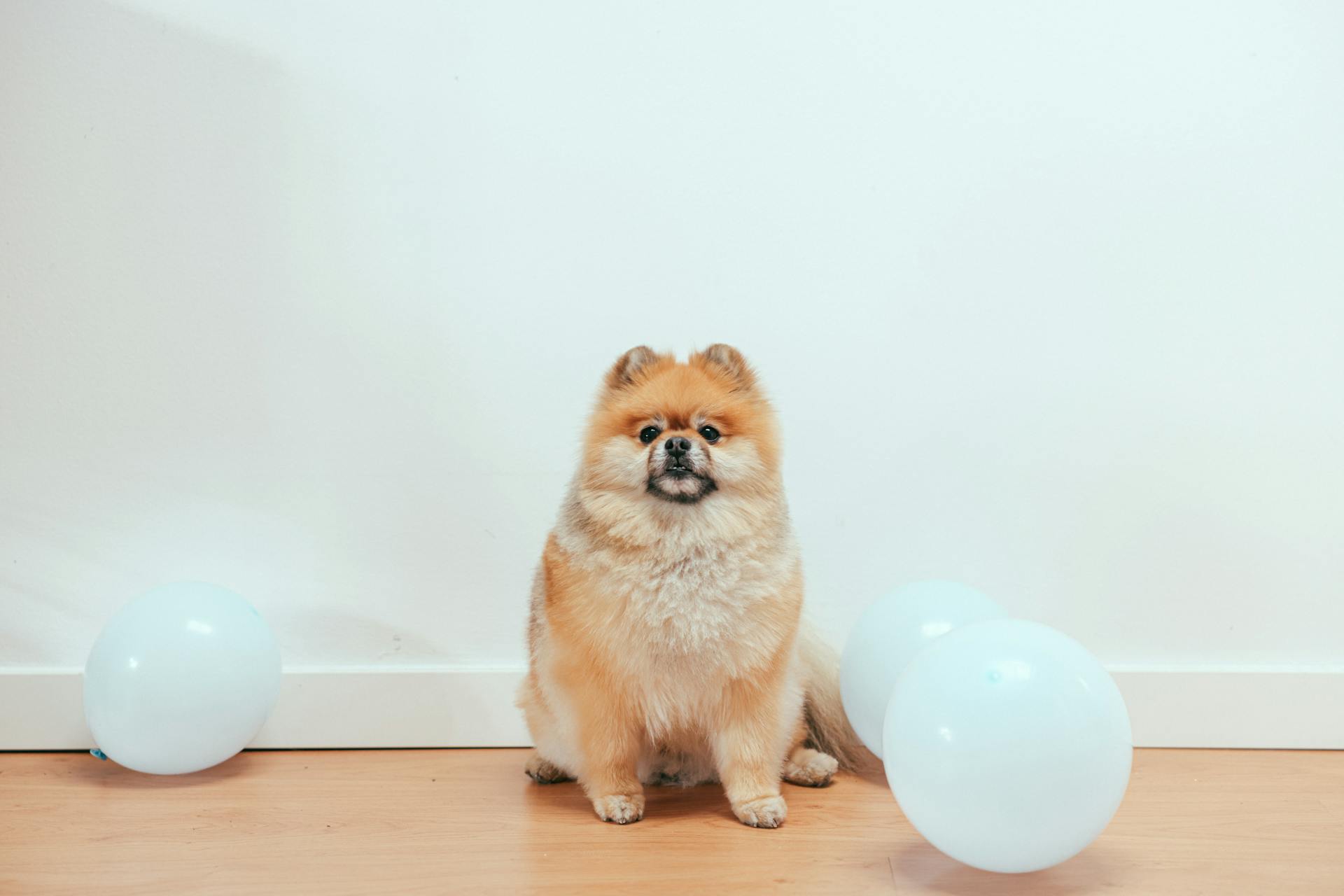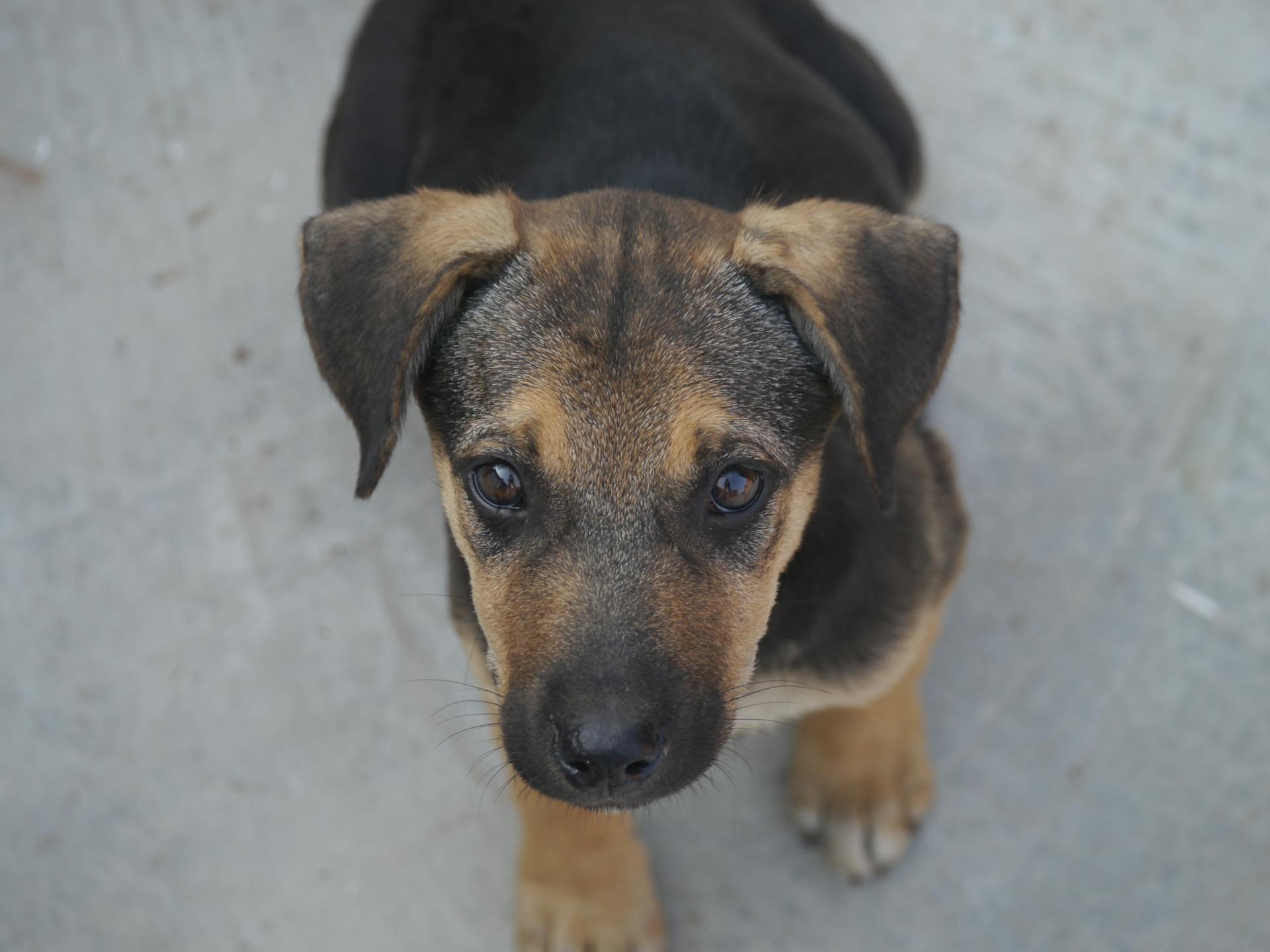
Puppies' zoomies are a normal part of their development, but it's natural to wonder when they'll outgrow this energetic phase.
Zoomies typically peak around 3-6 months old, as puppies start to explore their surroundings and burn off excess energy.
As puppies mature, their zoomies gradually decrease in frequency and intensity, often disappearing by 9-12 months old.
Puppies grow and develop at different rates, but most start to show a significant decrease in zoomies around 6-8 months old.
For your interest: Shih Tzu at 5 Months
What Are Dog Zoomies?
Dog zoomies, also known as FRAP (Frenetic Random Activity Period) attacks, are random bursts of high activity and energy that usually don't last long. They're characterized by your dog suddenly running around like crazy from one end of the house to the other, or running in frantic circles.
Puppies are especially prone to zoomies, and they can start as young as 8 weeks old. This is because they have lots of pent-up energy and need to express it in some way. Believe it or not, zoomies can also be a way for puppies to express contentment.
Here's an interesting read: When Is a Female Dog Fully Grown
If your puppy is under 4 months old, zoomies happen more frequently because it's difficult to exercise them outdoors due to vaccination restrictions. Veterinarians are strict about keeping pups indoors until they've had all their vaccines, usually around 4 to 5 months of age.
Here are some common signs of zoomies in puppies:
- Sudden bursts of high activity and energy
- Running around like crazy from one end of the house to the other
- Running in frantic circles
- Jumping on furniture
- Running under tables
Keep in mind that zoomies are a normal part of puppy development, and they'll eventually grow out of this stage.
Why Do Puppies Get Hyper?
Puppies get hyper due to a combination of factors, including a lack of structure, excess energy, sleep deprivation, and overstimulation.
Puppies thrive on routine and structure, so a defined schedule is essential to help them feel secure and relaxed. Lack of crate time can also contribute to restlessness and hyperactivity in the evening.
Excess energy is another major contributor to puppy hyperactivity. Puppies have boundless energy reserves, and if they haven't had enough physical and mental stimulation during the day, that energy will manifest itself in the form of late-night zoomies.
In fact, puppies need a lot of sleep, up to 18-20 hours a day, so sleep deprivation can also lead to overstimulation and crankiness, resulting in the puppy witching hour.
Here are the top reasons why puppies get hyper, along with some practical tips to help manage the behavior:
By understanding these factors and implementing practical strategies, you can help your puppy feel more relaxed and calm, reducing the likelihood of hyperactivity and the puppy witching hour.
Preventing and Managing Zoomies
Preventing and managing zoomies is crucial for your puppy's overall well-being. You can lessen the frequency or degree of zoomies by increasing physical exercise or challenging your dog mentally, which helps release pent-up energy.
A good amount of breed-appropriate exercise and mental stimulation is a great way to contend with an overly energetic young puppy. This can include activities like fetch, tug-of-war, and providing interactive toys to keep your puppy engaged. You can also consider crate training your puppy to help them decompress and relax.
Here are some practical strategies to make zoomies safer or reduce their occurrences:
- Provide a safe and enclosed area for your puppy to run around and release energy.
- Engage in interactive play with your puppy during the day to reduce the likelihood of hyperactivity at night.
- Train your puppy basic commands like "sit", "down", and "stay" to help redirect their behavior during zoomies.
How to Prevent
Preventing zoomies is possible by increasing physical exercise and challenging your dog mentally. This helps release pent-up energy before it's channeled into random bursts.
A good amount of breed-appropriate exercise is essential in preventing zoomies. You can also try increasing mental stimulation to keep your dog engaged and calm.
Most dogs will outgrow zoomies at a fairly young age, but in the meantime, providing a structured routine can make a big difference.
Here are some practical tips to help you prevent zoomies:
By implementing these strategies, you can help reduce the frequency and intensity of zoomies in your dog.
Managing the Catch-22
Managing the Catch-22 of Puppy Zoomies can be a challenge, especially if you can't take your puppy on long walks or play fetch outside.
Puppies need about 1 to 1 and a half hours of exercise a day, but you can make their zoomies safer or reduce their occurrences.
You can let your puppy have their zoomies, but it's essential to keep them safe at the same time. One way to do this is by blocking off areas you don't want them to access or by providing a safe space for them to run around.
Puppies thrive on routine and structure, so make sure you're crate training your puppy and letting them decompress in there.
Here are some ways to manage the catch-22 of puppy zoomies:
By following these tips, you can help manage the catch-22 of puppy zoomies and keep your furry friend safe and happy.
Aggressive Dog
Aggressive dog zoomies are a common occurrence in some puppies, and they can be quite intense. These episodes often include nipping or biting.
Redirecting your puppy's energy is key during these spells. Engaging in a game of tug of war with a favourite toy can help refocus their energy.
Attaching a short lead can also help maintain better control during aggressive dog zoomies. This can prevent accidents and keep both you and your puppy safe.
Age-Related Calmness
Puppies between four and six months old are still energetic, but their attention span is longer, making training easier if you're consistent.
This age is also when many puppies begin experiencing aggression and anxiety, which needs to be dealt with promptly through training.
Small breeds tend to mature faster than large ones and will likely calm down sooner, but even within breeds, there can be a lot of variation in how each individual dog develops.
The first six months are generally when puppies are the most playful, active, and mischievous, but they can remain relatively high-energy until they reach 12 or even 18 months old.
As puppies reach social maturity around 12 weeks old, their energy levels will start to become more manageable, but they'll likely still be quite active and playful.
By the time they reach 12 to 24 months, puppies should be calmer and more focused, but may still need regular physical activity to better control their energy levels.
Recommended read: 6 Month Old Shih Tzu Behavior
When Puppies Calm Down
As your puppy grows and matures, you may find that their energy levels decrease, and they become less hyperactive. Generally, puppies reach physical maturity between 6 to 12 months old, but their energy levels can remain high until they're 12 or even 18 months old.
Puppies between 6 to 12 weeks old are in a period of hyperactivity and increased curiosity, and they'll try to put just about anything in their mouths. Staying patient and consistent with training is key during this phase.
At 12 weeks to 6 months old, puppies become more aware of potential dangers and can start to get scared or anxious, but their hyperactivity may subside a bit. They'll likely still be quite active and playful, and may start testing boundaries more.
Puppies between 4 and 6 months old are still energetic, but their attention span is longer, making training easier. However, this is also the age when many puppies begin experiencing aggression and anxiety, which needs to be dealt with promptly.
Small breeds tend to mature faster than large ones and will likely calm down sooner, but even within breeds, there can be a lot of variation in how each individual dog develops.
Here's a rough guide to what you can expect in terms of puppy calmness:
Keep in mind that every dog is different, and the age at which your puppy calms down will depend on their breed, size, temperament, and individual development.
Breed of Dog
If you're thinking about getting a puppy, it's a good idea to spend some time at a dog park to get a sense of the dog breeds that are naturally energetic and which are more laid back.
A Sable German Shepherd and a Fluffy Frenchie will have much different energy levels, so it's worth observing different breeds to see which ones match your lifestyle.
Some breeds with notably high energy levels, even in adulthood, include Dachshunds, Terriers, and Greyhounds.
Frequently Asked Questions
How long do zoomies last a puppy?
Zoomies in puppies usually last a few minutes, but can vary depending on the individual dog's energy levels. Puppies tend to experience zoomies more frequently due to their high energy levels.
At what age are puppies most hyper?
Puppies are typically most hyper between 10-16 weeks old, a stage of rapid growth and development. This energetic phase is a normal part of their growth, but understanding it can help you prepare for the challenges and joys of puppy ownership.
Sources
- https://wildearth.com/blogs/dog-knowledge/when-do-puppies-calm-down
- https://www.petplan.co.uk/pet-information/dog/advice/zoomies/
- https://petpedia.co/what-age-do-puppy-crazies-stop/
- https://topdogtrainingny.com/puppy-training-how-to-handle-the-zoomies/
- https://balancedpackk9training.com/puppy-witching-hour/
Featured Images: pexels.com


